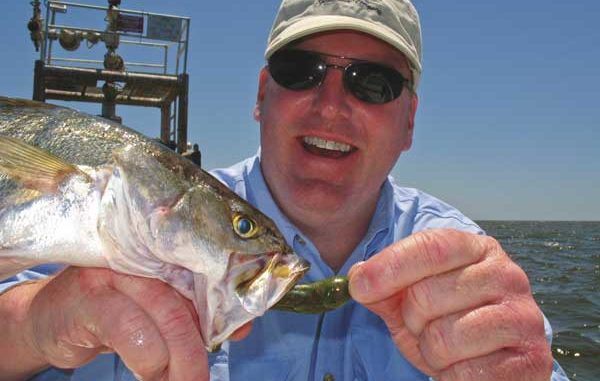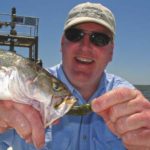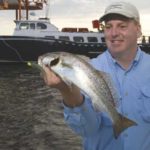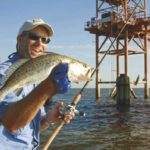
Head south of DuLarge to catch speckled trout until your arms just can’t take it any more.
Imagine that you are fishing a coastal lake and there is only one oyster reef smack dab in the middle of it — no cuts, no canals, no points, just that one solitary reef.
Don’t you think trout would stack up on it like wobbly women passing out at a Barack Obama campaign rally?
While this kind of situation might seem too much of a fantasy for inshore anglers, those who head offshore to fish the nearby rigs in the Ship Shoal area below Bayou DuLarge in Terrebonne Parish can kind of understand what this fishing fantasy would be like.
Something starts to happen during the middle of May that sends legions of speckled trout down Bayou DuLarge, through Sister Lake and out to the Ship Shoal blocks.
And according to Capt. Bill Lake with Bayou Guide Service, biologists say just as many trout, if not more, move to the rigs from unknown locations far offshore.
No matter where these fish come from, trout anglers should thank their lucky stars Louisiana is one of the few states in the nation that allows oil exploration off its coast because any of the oil industry’s main rigs or satellite rigs could become that solitary oyster reef at any time from May through September.
“(A rig is a) giant piece of structure that is essentially the basis for the food chain in that particular location,” said Lake. “Trout love these rigs, and they are the focus of most of our fishing during the summer months. But it’s not so much the rig itself that attracts the trout; it’s all the bait that is attracted to the rig, which is what attracts the trout.”
The numbers of trout that any of the Ship Shoal rigs can give up during the summer is staggering.
Take Capt. Marty LaCoste with Absolute Fishing Charters for example. He posted 125 fish a day for two days in May. That’s when he called to invite me to get in on the action.
“It’s a slam dunk,” he said as we made our plans. “Our plan is to go get 75 fish as quickly as we can (LaCoste had invited Capt. Joel Wakeland of Ponchatoula to fish with us). That should be around 9:00. Then we’re going to be in for a real treat, but I’m not going to let you in on what that is just yet.”
I got my first clue when LaCoste stopped his big Blazer Bay boat to get some live croakers on the way out of Bayou DuLarge. He had already told me we were going to be fishing tandem rigs with a variety of soft-plastic lures. I could only assume the live bait was for something bigger and better to come after we filled our limits.
The trip through Sister Lake into the Gulf of Mexico was just about as smooth as one could ask for. LaCoste could hardly contain his excitement as he finally revealed what we would be doing.
“I’ve been wearing out the trout on rig 26,” he voiced over the whine of his outboard. “I think we can get 65 there pretty quickly — then it’s out to the Ship Shoal lighthouse to work these live croakers. I don’t go out there a lot, but with such a calm day as this, I don’t see how we can pass it up. The lighthouse usually holds some giant trout, but it very rarely gets fished.”
As we eased up to rig 26, LaCoste noticed there was very little tide moving through the maze of metal and wooden pilings. He didn’t seem to care, although he did mention that moving water was one of the most important factors that improve trout fishing on the rigs.
We started pecking around with tandem rigs loaded with watermelon/red (locally known as avocado) Berkley Gulp! Goby soft plastics and Berkley Gulp! Swimming Mullets. LaCoste explained that if we figured out the fish preferred one over the other, we would change to fishing two of whichever they liked.
LaCoste had some of the Gulp! Alive! Shrimp, but he didn’t believe they would be as effective as the Goby because of the sudden drop in shrimp numbers during the days leading up to our trip.
“Cleaning fish the last few days, I’ve noticed that few if any of them had shrimp in their stomachs,” he said. “Pogies and croakers seem to be what they’re feeding on right now, so we’ll stick with a body style that resembles what they want to eat.”
It didn’t take long for the party to begin. LaCoste and Wakeland almost immediately started getting bit, albeit one fish at a time. I had never fished a tandem rig before, so it took a little expert coaching on the part of LaCoste to get me up to speed.
“First off, you’ve got to let it go all the way to the bottom,” he explained. “Then you just kind of pull it back while maintaining a tight line. If we had any current, we would just let it push the baits along while staying in contact with them. But today we’re going to have to move them ourselves. Drag it, keep your line tight and twitch it every now and then. You’ll get bit.”
With three of us now catching one fish about every 10 casts, it looked like it might take longer than 9:00 to get our limits. This was the same rig where LaCoste had slammed the consecutive 125-fish limits the preceding two days. He was confident the fish were still there. Where else would they go?
And the fact that Lake was catching fish on the other side of the same rig kept our spirits up.
Just as the bite started to get faster, the profile of a crew boat grew larger in the distance. Realizing that this was the only rig around, LaCoste announced that they would be coming right at us. He uttered his mild displeasure at them parking right on top of our spot, but since they didn’t shut down the motors, he determined that they would quickly be leaving. We stayed put and kept fishing.
After talking to Lake later that evening, I learned that the goings and comings of crew boats is just a part of rig fishing that anglers have to learn to accept.
“You can’t make them leave, so you might as well learn to fish around them,” he said. “These fish are used to those boats coming up there every day. What it does is if you happen to be catching fish off one of their loading docks, catching them every cast, when that boat comes up and puts those thrusters on and backs in, he’s going to screw it up. Most people are going to leave in that situation.”
Lake continues to catch trout off a rig that a crew boat has just tied up to by untying his boat and moving to the other side if he’s catching fish. A lot of times, the fish will just shift sides, and the prop wash is what makes them move.
“You may think this is crazy,” Lake said, “but I’ve had days when those boats would come in on days when the current wasn’t very strong and actually make the bite better just by pushing water through the legs of the rigs. I’m on the other side of the rig fishing in that current, and when the boat leaves they stop.”
In Lake’s experience, a crew boat is going to do one off two things: Either it’s going to drop off some people and be gone in a few minutes, or it’s going to tie up, turn off the motors and sit there a few hours. When the engines go off or the boat leaves, usually you can start catching fish again right where the boat’s sitting or from right where it just left.
This particular boat looked like it would be leaving soon, so we continued to peck around the edges of the rig while we waited it out. Apparently, the fish didn’t care too much that it was there because we continued catching fish with it sitting there with engines running.
The funny thing was that the fishing seemed to shut down after the boat left. We kept moving, though, and eventually stopped on top of a giant school of trout that was reminiscent of LaCoste’s previous two days.
“It gets like that on the rigs sometimes,” he said. “The fish aren’t where you expect them to be, but they’re still around. They’re not leaving the rig, though, so you’ve just got to find them. This looks like a pretty good school of fish right here.”
We found the fish out in open water between the main part of the rig and one of its offshoots. The tale-tell sign that we were on them big time was that my first cast out to the open water with tandem watermelon/red Gulp! Gobies produced two fish. The next produced two more, and the next two more.
The action continued like that until we reached 65 fish, which was 10 shy of our limit. LaCoste wanted to save room for whatever we caught out by the lighthouse, so off we went. The water wasn’t as smooth as we had hoped, but it was passable, and we eventually arrived at the towering rusty metal structure.
With live croakers on bottom in 18 feet of water at the base of the lighthouse, we began filling the rest of our limit with larger trout. Although the really big fish didn’t show up, we did see a marked increase in the size of the fish we landed.
“We might have had to wade through the sharks, bluefish and ladyfish to get them,” said LaCoste, “but you can see the difference in the size of the fish in this deeper water. Here, you might even catch a keeper lemonfish or two on the croakers, but it’s mainly about the big trout. A 5- to 7-pound trout isn’t out of the question.”
Like LaCoste, Lake has been fishing this area for several years. He’s basically seen it all when it comes to rig fishing, and gladly passes along his experiences to others to help them become better anglers.
“The first thing is that nobody can predict what will happen at these rigs when you head out in the morning,” he said. “You never know which rig is going to produce and which rig isn’t. And it doesn’t make sense, but it’s just like predicting tides out there — you can’t do it.
“There’s no way you can predict the tides at any of the rigs. There’s no tide chart you can look at. You just have to go. But don’t go out there when the tide range is 2 feet or greater because nine out of 10 times you’re wasting your time — the current will be moving too hard.”
Lake likes to see a tide range in the 0.6- to 1.5- foot zone. Anything more than 1.5 means it’s flying, and you would struggle getting your bait to the bottom. Anglers would even have to consider putting weights on their tandem rig to make it sink, which means they’re going to lose the sensation required to feel the bite.
“And from fishing these rigs all these years I’ve fished them,” Lake added, “I’ve noticed that I do best when I set up my boat to fish upcurrent. It’s just not as productive fishing downcurrent, although it may seem easier to some anglers. The best days come from fishing tandem rigs upcurrent when there’s some water movement. That’s the key to fishing these rigs.”
After comparing notes with Lake’s boat at the end of the trip, we learned that not only did we have our limit, but also that his boat had its 100-fish limit. He had his son Chris and two women in the boat with him, and they landed all their fish on Lake’s favorite LSU-colored Bayou Chubs.
Lake and LaCoste never wavered in their confidence, but they did admit that it was a little bit of a surprise considering that we had almost zero current that day.
“That’s what you can expect at the meat rigs,” Lake said. “We’ll maul these fish all summer long in the right conditions, and even sometimes when it’s not entirely perfect. We’ll have to change from our soft plastics to live croakers when the water gets into the high 80s, but the mauling will continue.”
It’s enough to make wobbly women, and men, pass out at the thought of it.
Contact Capt. Marty LaCoste at 985-856-4477 or www.absolutefishingcharters.com and Capt. Bill Lake at 985-851-6015 or www.captlake.com.





